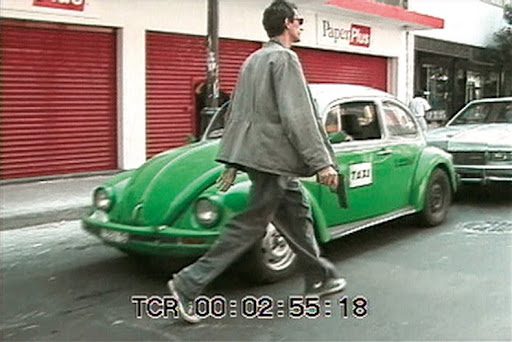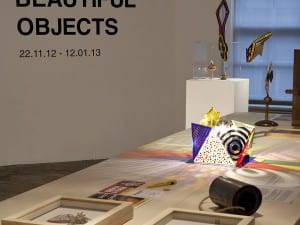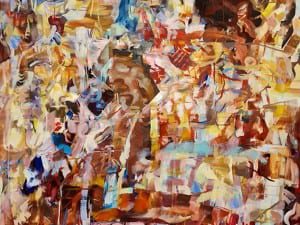Francis Alÿs: A Story of Deception at The Museum of Modern Art and MoMA PS1 opens on 8 May, drawing upon MoMA’s unique and important collection of work by Belgian artist Francis Alÿs (b. 1959), who uses poetic and allegorical methods to explore the social realities of political concepts, including the cyclical nature of change in modernizing societies, the urban landscape, and patterns of economic progress. Alÿs’s personal, ambulatory explorations of cities form the basis for his practice, through which he compiles extensive documentation reflecting his process, producing complex and diverse bodies of work that include video, painting, performance, drawing, and photography. Organized in collaboration with Alÿs, this exhibition is conceptually grouped around three major recent acquisitions— Re-enactments (2001), When Faith Moves Mountains (2002), and Rehearsal I (Ensayo I) (1999–2001)— each on view for the first time at the Museum. Using the mechanics of rehearsal and re-enactment in urban environments, Alÿs comments on the politics of public space with both solitary actions and large-scale collaborations, where the culmination of many small acts achieves mythic proportions.
Francis Alÿs studied architecture in Tournai and Venice before moving to Mexico City in 1986, where he has lived since. While this displacement has provided him with a unique vantage point on the country, Alÿs’s awareness of his outsider status is reflected in several of his projects. Alÿs’s works frequently begin with an action performed or initiated by him that can be witnessed in real time but also discovered through its documentation after the event. Large-scale installations such as Re-enactments, When Faith Moves Mountains, and Rehearsal I (Ensayo I) contain each of these aspects: the conceptualization and planning of the piece and action, the action itself, the distillation of the action, the video documentation, and the related materials.
In 2001 in Mexico City, Alÿs performed Re-enactments, for which he purchased a 9mm Beretta handgun and proceeded to wander around the city’s downtown with the loaded gun in hand. After 11 minutes of walking, Alÿs was detained by the police and eventually released. With the cooperation of the Mexican authorities Alÿs re-enacted the very same scene one day later. Within MoMA’s galleries, a two-channel video of the original action and its re-enactment are projected side by side, while related drawings, maps, newspaper clippings, and photographs accompany the videos. The video presentation of the action alongside its re-enactment underscores the ambiguities between reality and fiction, while anticipating the way public safety came to dominate the social and political debate within Mexico during the first decade of the 21st century.
For When Faith Moves Mountains, 500 volunteers in Lima, Peru, were equipped with shovels and asked to displace a 550-yard-long sand dune, moving it four inches from its original location. This work — Alÿs’s contribution to the 2002 Lima Biennale, stages a collective exercise in futility in which hundreds of people attempt to move a mountain. The work raises questions about the outcomes of social actions, highlighting how substantial efforts can be out of proportion with the gains achieved. MoMA’s installation includes videos of the action, drawings, maps, and storyboards.
For Rehearsal I (Ensayo I), Alÿs staged a scene in which the driver of a Volkswagen Beetle repeatedly attempted in vain to scale a dusty slope on the outskirts of Tijuana. The driver listened to a tape recording of a musical rehearsal by a Mexican brass band and mimicked the recording, starting and stopping as the band did. The installation includes several videos, paintings, and drawings. Eight other bodies of work are also on view at MoMA, including Tornado (2000–10), which was acquired by the Museum in 2011. For Tornado, Alÿs visited the highlands south of Mexico City throughout the past decade in a repeated effort to chase the whirling dust storms that occur annually in the region. With camera in hand, the artist attempted again and again to run directly into a tornado to penetrate the eye of the storm. Culled from footage recorded over a period of 10 years, the video symbolically combines the sublime with the unattainable and can be considered a metaphor for failed pursuits of utopian ideals, and man’s repeated attempts to persist despite inevitable consequences.
Challenging the powers of nature in a perplexing one-on-one confrontation, Alÿs recognizes human persistence and emphasizes the necessity to pursue ideals however unattainable or seemingly absurd. For Song for Lupita (1998), the artist has created an installation in which a film strip loops continuously through a reel that extends up to the ceiling, projecting an animated pencil drawing of a young female character pouring a liquid from one glass to another in an endless and poetic gesture. Paradox of Praxis I (Sometimes Doing Something Leads to Nothing) (1997), a five–minute video showing Alÿs pushing a block of ice through the center of Mexico City until nothing but a small puddle of water remained, is an allusion to the hardship involved in the daily survival tactics of many people in the region. Le Temps du Sommeil (1996―present) is an ongoing series composed of more than 100 small canvases of approximately 4.3 x 6” each, which Alÿs continues to rework as a sort of evolving record of visual ideas that develop out of actions or precede them.
Francis Alÿs: A Story of Deception expands to MoMA PS1 with a series of works that highlights the artist’s engagement with cities around the globe, from London to New York to Venice. These projects, which include The Modern Procession (2002), Guards (2004), and Duett (1999), reveal the sense of disconnection, fragmentation, and displacement often present in large cities, and also playfully attempt to overcome such disjunctions. A Story of Deception (2003–06), a 16mm film depicting a mirage looming on the horizon in Patagonia, representing that which is continually sought after yet inevitably out of reach, is also on view.
The Modern Procession was commissioned by MoMA to mark the Museum’s temporary relocation to Queens (2002–04) while its midtown building was undergoing a renovation and expansion. Through video, photographs, and drawings, the installation documents a ceremonial procession that occurred on June 23, 2002, in which Alÿs, musicians, and various participants traveled from MoMA to MoMA QNS, carrying the artist Kiki Smith on a palanquin and representations of works in the Museum’s collection, including works by Pablo Picasso, Marcel Duchamp, and Alberto Giacometti. On view is a two-channel video of the event, along with numerous archival materials related to it. The procession not only made the historic transition public and visible, but linked Manhattan and Queens through ceremony and spectacle. Guards includes a single-channel video in which Alÿs orchestrated the movements of 64 Royal Guards who entered The City of London by different streets, unaware of each other’s location. Upon running into each other, the guards would fall into step and march together, looking for more guards with which to join. Standing as a social allegory, the work reflects the tendency of individuals to seek identity in group formations.
For the 1999 Venice Biennale, Alÿs created an unofficial performance for the occasion, titled Duett. The piece begins with Alÿs entering Venice by train while fellow Belgian artist Honoré d’O landed at the airport, and each man is carrying one half of a tuba. After drifting through the labyrinth of streets, they eventually met three days later and reassembled the musical instrument. The work is emblematic of Alÿs’s exploration of estranged or misplaced halves striving for reconciliation. At MoMA PS1, Duett is displayed as a single-channel video along with photographic documentation and ephemera related to the performance.
Francis Alÿs: A Story of Deception opens May 8 and continues until August 1. For further information please visit: www.moma.org
Image:
Francis Alÿs
Re-enactments (2001)
The Museum of Modern Art, New York.
© Francis Alÿs





